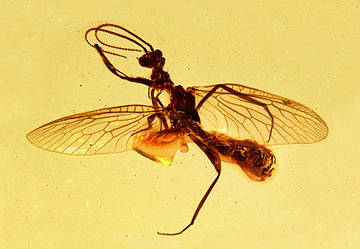Abstract
Eucnemidae is a relatively large beetle family belonging to the polyphagan superfamily Elateroidea. Numerous fossil eucnemids have been reported from Cenozoic deposits, but the Mesozoic record of Eucnemidae is much sparser. Here we describe and figure a new eucnemid beetle, Muonabuntor grandinotalis gen. et sp. nov., discovered from mid-Cretaceous Burmese amber (ca. 99 Ma). The new genus resembles extant Jenibuntor and Euryptychus in having simple hypomera and tubular antennomeres 9–11, but differs from the latter genera by its comparatively longer pronotum, weakly striate elytra, and large metacoxal plates. The fossil record and classification system of Eucnemidae are also reviewed.
References
Alexeev, A.V. (2008) New jewel beetles (Coleoptera: Buprestidae) and similar beetles from the Cretaceous and Early Paleogene of Asia. Paleontological Journal, 42, 53–59.
https://doi.org/10.1007/s11492-008-1008-9
Cai, C.Y., Tihelka, E., Pisani, D. & Donoghue, P.C.J. (2020) Data curation and modeling of compositional heterogeneity in insect phylogenomics: a case study of the phylogeny of Dytiscoidea (Coleoptera: Adephaga). Molecular Phylogenetics and Evolution, 147, 106782.
https://doi.org/10.1016/j.ympev.2020.106782
Chang, H.L., Kirejtshuk, A. & Ren, D. (2010) New fossil elaterids (Coleoptera: Polyphaga: Elateridae) from the Jehol Biota in China. Annals of the Entomological Society of America, 103, 866–874.
https://doi.org/10.1603/AN09076
Chang, H.L., Muona, J., Pu, H.Y., Xu, L., Wang, C., Teräväinen, M., Ren, D., Yang, Q., Zhang, X.L. & Jia, S.H. (2016) Chinese Cretaceous larva exposes a southern Californian living fossil (Insecta, Coleoptera, Eucnemidae). Cladistics, 32, 211–214.
https://doi.org/10.1111/cla.12124
Dolin, V.G. (1975) A contribution to the systematics of the Mesozoic click-beetles (Coleoptera, Elateridae). Paleontological Journal, 4, 51–62 [In Russian].
Grimaldi, D. & Engel, M.S. (2005) Evolution of the Insects. Cambridge University Press, Cambridge, 755 pp.
Kirejtshuk, A.G., Ponomarenko, A.G., Kurochkin, A.S., Alexeev, A.V., Gratshev, V.G., Solodovnikov, A.Y., Krell, F.-T. & Soriano, C. (2019) The beetle (Coleoptera) fauna of the Insect Limestone (late Eocene), Isle of Wight, southern England. Earth and Environmental Science Transactions of the Royal Society of Edinburgh, 110, 405–492.
https://doi.org/10.1017/S1755691018000865
Kundrata, R., Bocakova, M. & Bocak, L. (2014) The comprehensive phylogeny of the superfamily Elateroidea (Coleoptera: Elateriformia). Molecular Phylogenetics and Evolution, 76, 162–171.
https://doi.org/10.1016/j.ympev.2014.03.012
Kusy, D., Motyka, M., Andújar, C., Bocek, M., Masek, M., Sklenarova, K., Kokas, F., Bocakova, M., Vogler, A.P. & Bocak, L. (2018) Genome sequencing of Rhinorhipus Lawrence exposes an early branch of the Coleoptera. Frontiers in Zoology, 15, 21.
https://doi.org/10.1186/s12983-018-0262-0
Lartillot, N., Brinkmann, H. & Philippe, H. (2007) Suppression of long-branch attraction artefacts in the animal phylogeny using a site-heterogeneous model. BMC Evolutionary Biology, 7, S4.
https://doi.org/10.1186/1471-2148-7-S1-S4
Lawrence, J.F., Muona, J., Teräväinen, M., Ståhls, G. & Vahtera, V. (2007) Anischia, Perothops and the phylogeny of Elateroidea (Coleoptera: Elateriformia). Insect Systematics & Evolution, 38, 205–239.
https://doi.org/10.1163/187631207794761001
Lawrence, J.F., Ślipiński, A., Seago, A.E., Thayer, M.K., Newton, A.F. & Marvaldi, A.E. (2011) Phylogeny of the Coleoptera based on morphological characters of adults and larvae. Annales Zoologici, 61, 1–217.
https://doi.org/10.3161/000345411X576725
Letunic, I. & Bork, P. (2019) Interactive Tree Of Life (iTOL) v4: recent updates and new developments. Nucleic Acids Research, 47, W256–W259.
https://doi.org/10.1093/nar/gkz239
McKenna, D.D., Shin, S., Ahrens, D., Balke, M., Beza-Beza, C., Clarke, D.J., Donath, A., Escalona, H.E., Friedrich, F., Letsch, H., Liu, S., Maddison, D., Mayer, C., Misof, B., Murin, P.J., Niehuis, O., Peters, R.S., Podsiadlowski, L., Pohl, H., Scully, E.D., Yan, E.V., Zhou, X., Ślipiński, A. & Beutel, R.G. (2019) The evolution and genomic basis of beetle diversity. Proceedings of the National Academy of Sciences, USA, 116, 24729–24737.
https://doi.org/10.1073/pnas.1909655116
Muona, J. (1993a) Review of the phylogeny, classification and biology of the family Eucnemidae (Coleoptera). Entomologica Scandinavica Supplement, 44, 1–133.
Muona, J. (1993b) Eucnemidae and Throscidae in Baltic Amber. Entomologische Blätter, 89, 15–45.
Muona, J. (2010) Eucnemidae Eschscholtz, 1829. In: Leschen, R.A.B., Beutel, R.G., Lawrence, J.F. (Eds), Handbook of Zoology, Arthropoda: Insecta, Coleoptera, beetles, Vol. 2: morphology and systematics (Elateroidea, Bostrichiformia, Cucujiformia partim). Walter de Gruyter, Berlin and New York, pp. 61–69.
https://doi.org/10.1515/9783110911213.61
Muona, J. & Teräväinen, M. (2020) A re-evaluation of the Eucnemidae larval characters (Coleoptera). Papéis Avulsos de Zoologia, 60, e202060 (s.i.) 28.
https://doi.org/10.11606/1807-0205/2020.60.special-issue.28
Oberprieler, R.G., Ashman, L.G., Frese, M. & Ślipiński, A. (2016) The first elateroid beetles (Coleoptera: Polyphaga: Elateroidea) from the Upper Jurassic of Australia. Zootaxa, 4147 (2), 177–191.
https://doi.org/10.11646/zootaxa.4147.2.5
Otto, R.L. (2017) A revision of Phlegoninae (Coleoptera: Eucnemidae), with descriptions of a new genus and four new species. Insecta Mundi, 0569, 1–27.
Otto, R.L. (2019) Descriptions of two new elateroid beetles (Coleoptera: Eucnemidae, Elateridae) from Burmese amber. Insecta Mundi, 0702, 1–6.
Pisani, D., Pett, W., Dohrmann, M., Feuda, R., Rota-Stabelli, O., Philippe, H., Lartillot, N. & Wörheide, G. (2015) Genomic data do not support comb jellies as the sister group to all other animals. Proceedings of the National Academy of Sciences, USA, 112, 15402–15407.
https://doi.org/10.1073/pnas.1518127112
Poinar, Jr., G. (2013) Discoclavata dominicana n. gen., n. sp., (Coleoptera: Bostrichidae) and Lissantauga epicrana n. gen., n. sp. (Coleoptera: Eucnemidae) in Dominican amber. Historical Biology, 25, 107–113.
https://doi.org/10.1080/08912963.2012.712518
Rasnitsyn, A.P. & Ross, A.J. (2000) A preliminary list of arthropod families present in the Burmese amber collection at The Natural History Museum, London. Bulletin of the Natural History Museum, Geology Series, 56, 21–24.
Scudder, S.H. (1876) Fossil Coleoptera from the Rocky Mountain Tertiaries. Bulletin of the United States Geological and Geographical Survey of the Territories, 2, 77–87.
Scudder, S.H. (1890) The Tertiary insects of North America. Government Printing Office, Washington, 734 pp.
https://doi.org/10.5962/bhl.title.44698
Seung, J. (2017) Systematic study of family Eucnemidae (Coleoptera: Elateroidea) in Korea. Seoul National University, Seoul.
Seung, J., Lee, S. & Muona, J. (2017) Taxonomic review of Macraulacinae and Eucneminae (Coleoptera: Eucnemidae) from Korea. Journal of Asia-Pacific Entomology, 20, 569–575.
https://doi.org/10.1016/j.aspen.2017.03.005
Wappler, T. (2003) Systematik, Phylogenie, Taphonomie und Paläoökologie der Insekten aus dem Mittel-Eozän des Eckfelder Maares, Vulkaneifel. Technischen Universität Clausthal, Clausthal-Zellerfeld, 241 pp. [In German].
Wedmann, S., Poschmann, M. & Hörnschemeyer, T. (2010) Fossil insects from the Late Oligocene Enspel Lagerstätte and their palaeobiogeographic and palaeoclimatic significance. Palaeobiodiversity and Palaeoenvironments, 90, 49–58.
https://doi.org/10.1007/s12549-009-0013-5
Whitehouse, N.J. (2006) The Holocene British and Irish ancient forest fossil beetle fauna: implications for forest history, biodiversity and faunal colonisation. Quaternary Science Reviews, 25, 1755–1789.


